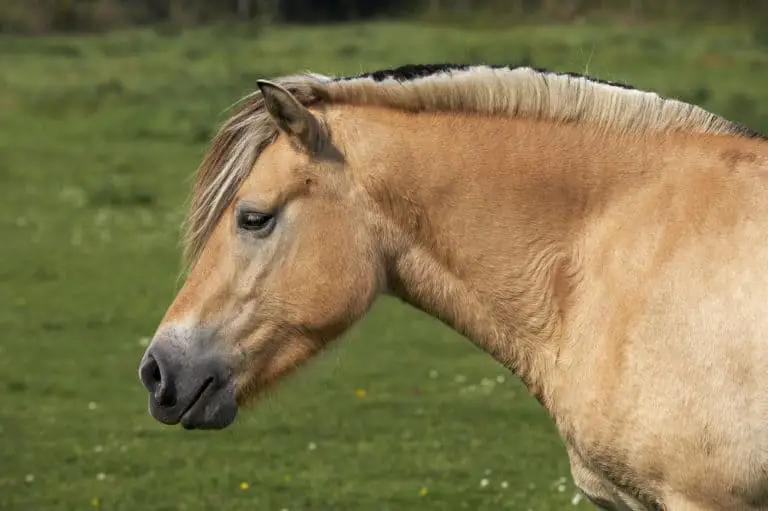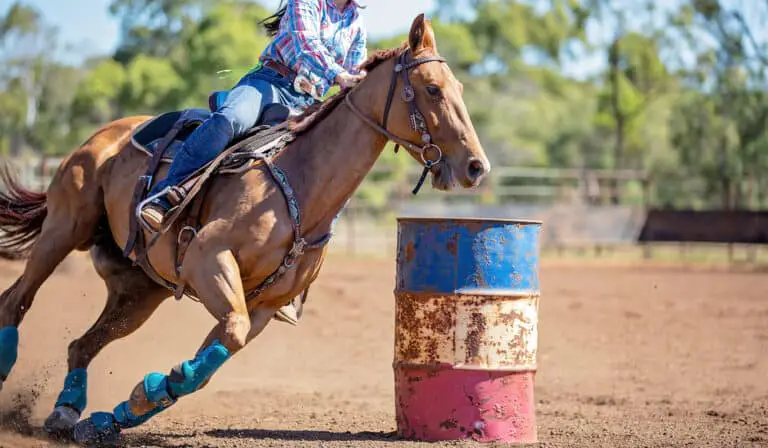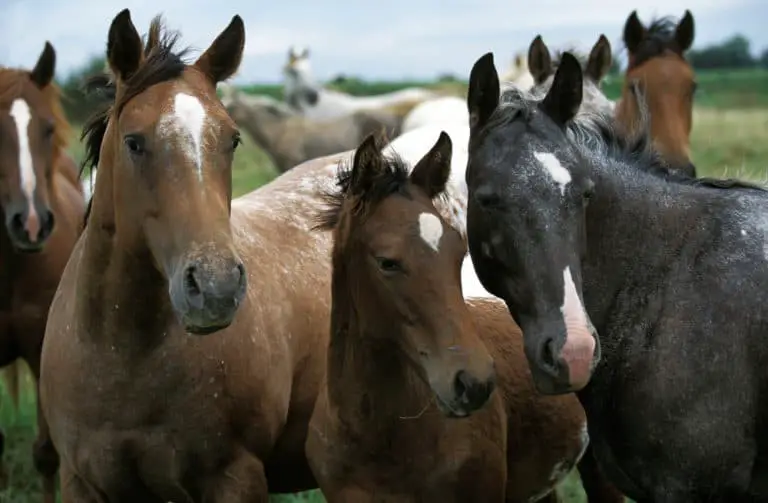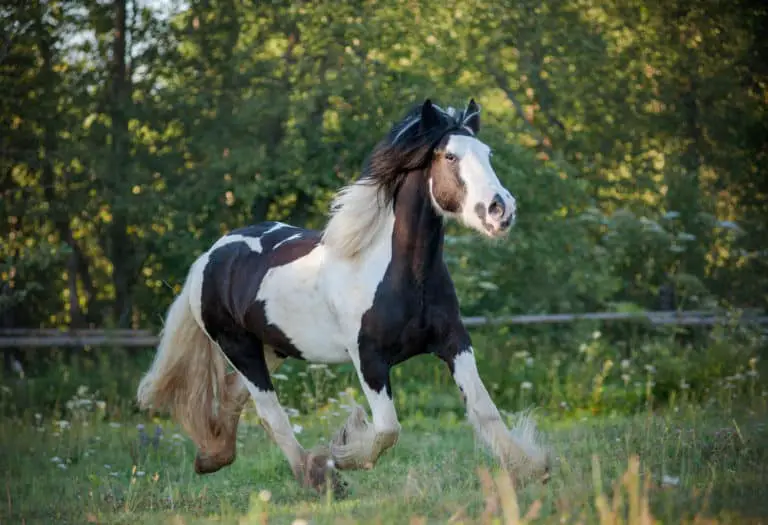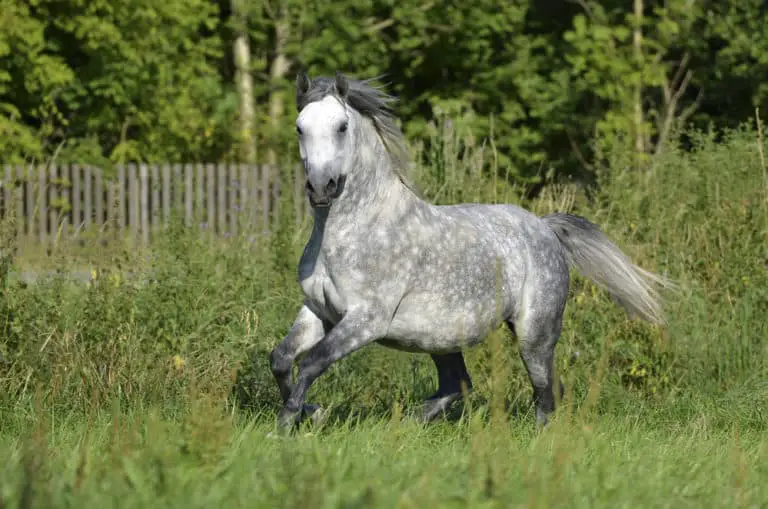Hanoverian Horse: Care, Cost & History (2025)
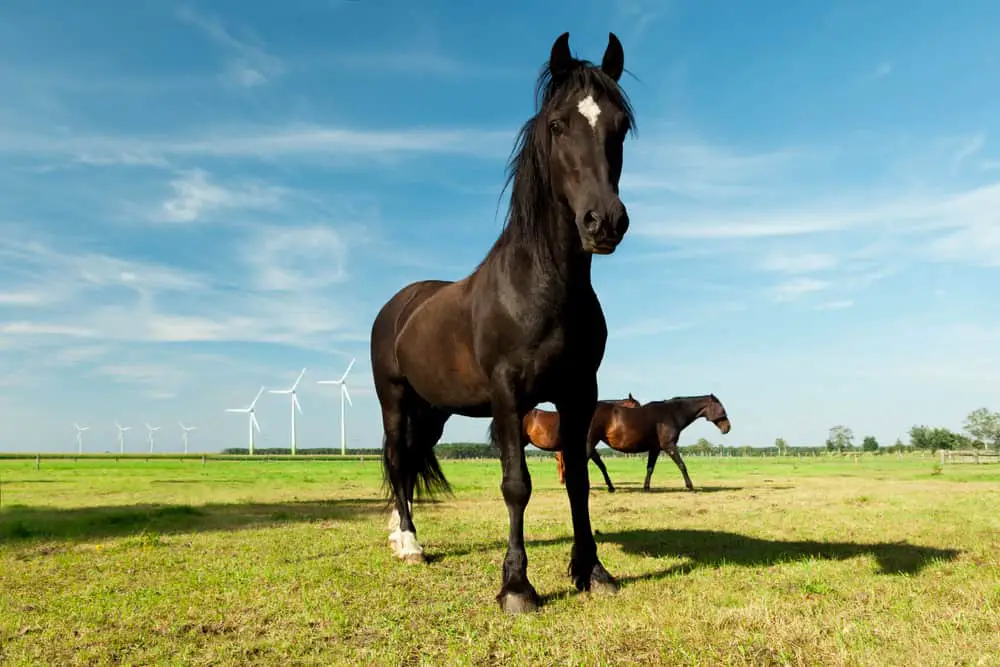
The Hanoverian horse is the dream of every competitive rider. The elegant and sporty German Horse breed is famous for being one of the most distinguished equine breeds throughout the world in almost all professional equine disciplines.
Their perfect suitability for dressage, jumping, and tournaments have made this breed the epitome of excellence and achievement in the equestrian community.
Breed: Hanoverian Horse
Adult Weight: on average 1433 lbs
Adult Height: 15.3 – 17.1 hands (63–69 inches)
Origin: Lower Saxony, Germany
Use: Dressage, Show, Jumping, Pleasure
Colors: Bay, black, grey, chestnut
Features: Big ears, muscular body, large nostrils
Lifespan: 25-30 years
Character: Good learners, nerves of steel, spirited, thriving
Gait: Smooth, Tactful, Elegant, spirited
Best for: All levels of riders
- Characteristics
- Hanoverian Horse Care
- Hanoverian Horse History
- Modern Hanoverians
- Cost and Ownership
- Buying a Hanoverian
- Similar Breeds
Hanoverian Horse Characteristics
Hanoverian horse characteristics are typified by excellence and distinguishment. A Hanoverian loves to learn and engage with his rider, which contributes to the breeds and their riders’ professional success. Furthermore, it is strictly regulated how a Hanoverian Horse should look.
The Hanoverian is a well-proportioned horse with the allowed coat colors of bay, chestnut, black, and grey. Their build is elegant, robust and they have strong limbs. The Hanoverian horse head is characterized by its classic proportion, long ears, and large nostrils.
Size
There are no breed standards for the official Hanoverian horse height, but Hanoverians tend to be 15.3 –17.1 hands (63–69 inches, 160 –175 cm) high (1). However, they vary in size and are suitable for riders of all heights, which comes in handy for dressage and jumping competitions (1).
The Hanoverian size can be considered average compared to other adult horse breeds (1). However, competitive riders usually prefer taller horses for competing as they tend to look more elegant and can sometimes jump more easily over high poles than smaller Hanoverians.
Weight
The average Hanoverian horse weight is approximately 1,433 lbs or 650 kg (1). The well-proportioned and muscular horses are strongly built and naturally come with some muscle weight.
Compared to other light horse breeds, their weight can be categorized as heavy. Light horse breeds usually weigh between 900 to 1,400 pounds (1).
Still, the Hanoverian Horse is not considered a heavy or big horse like a Draft horse, for example. They are still much lighter than draft horses that can weigh between 1,400 – 2,000 lbs (2).
Colors
The accepted Hanoverian horse colors are limited and strongly regulated by the Hannoveraner Verband in North Germany. Chestnut, Bay, Grey, and Black are the official coat colors of the Hanoverian (1). Those colors can be found relatively frequently throughout the world.
Rare Hanoverian horse colors like palomino or cremello will not be accepted by the Hannoveraner Verband (1). The Buckskin Hanoverian color is also not recognized by the breeding association. Small Markings of the coat are allowed, but too many of them are not appreciated (1).
Each and every beautiful Hanoverian horse that wants to be acknowledged by the Hannoveraner Verband in Germany will get a brand on their left-back thigh as a sign of being a registered member of the distinguished breed (1).
Temperament
Hanoverian horse temperament is extraordinary since they are spirited yet calm (3). The Hanoverian horse behavior is the perfect mixture of boldness, willingness to learn, and calmness (3). They have nerves of steel which is vital for participating in big tournaments and competitions with many people watching and cheering them.
They have been bred for hundreds of years to be willful learners (3). If you plan to learn and train a lot with your horse, the Hanoverian is a perfect fit for you. The Hanoverian breed has been propagated for performance and sports, so if you are looking for a horse to only use for grazing your paddocks, you might find a better fit.
Hanoverian Horse Care
The Hanoverian horse lifespan can be up to 25-30 years. To achieve such a respectable age for your Hanoverian horse, you must care for it frequently and extensively without exceptions.
There is a lot of care and time involved when it comes to caring for horses in general. You definitely must create a habit of grooming and caring for your Hanoverian.
Diet and Nutrition
The Hanoverian diet can be a little more demanding than other horse breeds. This is due to the fact that Hanoveranians are performance horses and usually need supplements and grain to be able to burn through all that needed energy (4). Still, they do not eat considerably more than the average sport horse (4).
Hanoverian horses are warmbloods, and their diet should mainly consist of a variety of forage and fresh hay. You may add some high-quality grain and vegetables, and fruits (4).
Regardless of how you use your Hanoverian gelding or mare, it must be fed accordingly to the diet of a warmblood. So even if you don’t use your Hanoverian for dressage or jumping, you should adhere to their recommended diet (4).
Health Problems
Hanoverians are known to be very healthy horses with few genetic problems (5). This is because every horse that wants to be registered as a Hanoverian by the Hannoveraner Verband needs to undergo significant testing and bloodwork by the breeding association(5).
The breeding association in Germany wants to make sure that no health problems or genetic diseases can be passed along within the accepted horses in their breeding association (5). And the Germans proved to be right by doing so as they successfully built one of the healthiest breeds of equines (5).
One genetic disease which is known to occur in Hanoverian horses is the osteochondrosis dissecans (OCD) which affects the joints of a Hanoverian while growing (5).
Grooming
Hanoverian grooming is similar to grooming a horse in general and, therefore, will be pretty demanding. Owning and caring for a horse will take up a lot of your free time (6).
If you compete with your horse in dressage or jumping, you must make sure to groom them properly after every training session to avoid diseases of the skin. Skin diseases could make you miss a tournament and affect your horse’s health and performance negatively (6).
Brush the coat of your horse every day with a body brush to clean it from small particles and to strengthen your relationship (6).
Wash the coat of your horse once every week (6). Use a Curry Comb to remove more severe dirt and grease from the skin and to stimulate the blood flow (6).
Hanoverian Horse History
The Hanoverian horse history has been well-documented and can be retraced quite well. The history of this horse has its beginning in the 16th century in the State of Lower Saxony in Germany (3). The year 1735 was the year when the State Stud was founded. The official Studbook followed a bit later in 1888 (3).
Origin
The Hanoverian horse’s origin can be traced back quite easily by its name. They are named after the capital city Hannover of the State of Lower Saxony in Northern Germany (3).
The British King Georg II. who was a Saxon himself founded the State Stud at Celle. He was also the elector of Hanover (3). The warmblood horse has been crossed with Thoroughbreds and Holsteiner horses to refine the breed (3).
Historic Development
Like with many other horse breeds during the 16th until the 18th century, the Hanoverian horses have been used in wars. When machinery became more affordable and more efficient for farmers, the agricultural purpose of the Hanoverian decreased. The breeding was adapted again when the need for general riding horses rose.
After the industrialization, the Hanoverians were also used as coach horses for some time (3) until they were bred to excel in sports and competition (3).
Nowadays many breeders, and especially the Hanoverian Association in Lower Saxony, claim to breed and produce the most excellent dressage horses in the world, and competitions do not prove them wrong so far (3).
Notable Hanoverian Horses
Since we already know that Hanoverian Horses are excellent dressage and competition horses, there are a lot of famous Hanoverian horses.
Many of those Hanoverians come from a notable Hanoverian horse pedigree and rose to fame quickly for their outstanding achievements.
Brentina
Brentina was a beautiful chestnut Hanoverian mare that has excelled in international dressage worldwide. Her rider was Debbie McDonald, and the pair won several competitions and titles in the United States and international competitions. Brentina was an excellent and elegant mare.
Salinero and Anky
Salinero was a beautiful black Hanoverian stallion. With his rider Anky van Grunswen from the Netherlands, he won numerous titles, the Olympic Games, and endless national and international championships. He had white markings on his forehead, feet, and nose. He was a stunning stallion of the Hanoverian breed.
Elvis and Nadine
Elvis is another sports legend of the Hanoverian breed. He was born in 1996 and won the Olympic games 2009 in Peking in the category of group tournament. His rider was Nadine Capellmann from Germany. Elvis was bred in Bremerhaven by Christian Pfeil.
Myths and Legends
There are somehow few Hanoverian horse legends, even though the history of this breed is well-documented. Maybe their versatile and everyday use for different aspects of living with horses de-mystified this stunning German Horse, or perhaps the specific breed was just not mentioned.
Chestnut Horse by Otto Erelman
The artist, Otto Erelman from the Netherlands, was known to paint and study several breeds of horses. One of these paintings shows a beautiful chestnut Hanoverian stallion in his stall. The horse seems spirited and maybe even distressed. The typical features of the Hanoverian look are well documented in this painting.
Battle of Oudenard
Georg II. participated in the Battle of Oudenard with his Hanoverian horse and his army. As the king of Britain and the elector of Hanover, he was known to adore and breed the Hanoverian Horse breed. His trusty steed was unfortunately killed in the Battle of Oudenard alongside his colonel. Georg II. remained unharmed and survived the Battle of Oudenard.
The White Horse of Hanover
The father of Georg II. was Georg I. which makes sense, right? Well, when the last Stuart died, Georg of Hanover was handed the throne and became kind of Great Britain. Georg of Hanover, who became Georg I., brought his heraldry with him, which was showing a mystical white horse. Some wonder if this horse might be a Hanoverian even though Hanoverians are typically not white.
Modern Hanoverian Horses
The modern Hanoverian Horses are considered one of the top-notch breeds in the equine community. They are the most famous horse in Europe for dressage and show jumping and hold several records.
The different types of Hanoverian horses are suited for many riders, and the breed is loved more than ever.
Breeding
Hanoverian breeding is still most prevalent in Lower Saxony, Germany, which is the true origin of Hanoverians Horses (1).
But the Hanoverian breed has been exported throughout history to many countries due to its excellent capabilities and is a beloved horse for many breeders worldwide (1). Those countries include the Netherlands and the United States, where the riding culture is strong.
Hanoverian horses breeding still focuses on the uses of dressage, showjumping, and competition in general (1). Their muscular bodies, elegant built and robust body type are still amongst the most crucial breeding goals (1).
Population
When it comes to the Hanoverian horse population, the numbers indicate how vital this horse breed is worldwide (7). More than 16,000 registered Hanoverian mares are registered with the official breeding association and more than 300 Hanoverian stallions worldwide (7).
These numbers are not as high as for other popular horse breeds, and this is due to the rigorous breeding rules that are applied by the Hannoveraner Verband in Lower Saxony (7). Many say the strict breeding standards are the key to the Hanoverian’s success (7).
Unfortunately, there is no current verified number of the Hanoverian Horse population in the United States.
Uses
The Hanoverian horse uses are versatile and one of their best features. Since the Hanoverian horse gait is known to be the most elegant and tactful within many popular dressage breeds, they are mainly used for dressage and show purposes by many riders (3).
Still, many people adore this breed for its great character and use them simply for pleasure (3).
The Hanoverian Horse is very acclaimed and achieved in the Olympic disciplines as well, and we can’t remember a year when a Hanoverian has not competed in the Olympic games. Furthermore, Hanoverian jumping became popular worldwide since they are excellent jumpers (3).
Hanoverian Horse Prices
When it comes to buying a Hanoverian horse and its upkeeping, the costs can be higher than those of other breeds. The initial Hanoverian horse price for a registered equine of this breed can indeed be quite hefty since the german breeding rules are strict and non-negotiable.
Purchase Price
Since the Hanoverian Horse is considered an excellent and acclaimed horse breed, one might think this is a reason for them being super expensive, and they are not wrong. Hanoverian Horses, if officially registered, can be costly. (8)
As with all horse breeds, the pedigree, health status, Hanoverian horse training, and physical data determine a Hanoverian horse’s purchase price (8).
The average Hanoverian horse with a history of professional dressage and a registry in the studbook costs between $16,000 up to $45,000 (8). You can buy a Hanoverian for much less, say $4,000, but chances are high the horse will not be registered in the studbook (8).
Ownership Costs
It is essential that when you decide to buy a Hanoverian horse, you are aware of the Hanoverian horse cost of ownership that comes with owning your horse. And that is aside from the initial Hanoverian price.
The monthly costs of ownership should be taken into consideration: board, feed, veterinarian care, and hoof care are just some of the regular prices, which can easily be as high as $1,000 a month.
Board
The Hanoverian horse board cost will be around $150-300 monthly (9). If you pay for full board, which includes regular vet care, feed, hoof care, and exercising your horse, the monthly boarding cost will be higher, around $400, than just paying for putting your horse in a stable, which can cost as little as $150 (9).
Feed
When it comes to Hanoverian horse feed cost, you have to pay for high-quality hay and ensure your Hanoverian can forage through good pasture (10). A bay of hale will cost around 2$-$4. Horses need about 15-30 bales per month (10).
If your horse is active in dressage or jumping, it needs more energy, and you have to add some premium grain feed which is around $16 for a bag that lasts about 1-2 weeks (10).
Veterinary Care
The Hanoverian horse veterinary cost will be around $200-$300 if nothing out of the ordinary occurs. These costs cover annual vaccinations, deworming for 12 months, and teeth floating once or twice per year.
This estimate does not include anything unexpected like injuries, inflammations, or colics. Keep in mind that you have to watch out for OCD. If your horse has OCD, you will be confronted with more unexpected costs.
Hoof Care
The Hanoverian horse hoof care cost is regular since you need to regularly shoe or trim their hooves. Trimming your horses’ hooves will cost around $20-$35 for each trim. Shoeing your horse will cost you more than twice as much – approximately $80 (11).
This brings the annual costs to anything from $150 to over $1,000, depending on your Hanoverian hoof care (11).
Buying a Hanoverian Horse
If you have decided to buy a horse of the Hanoverian breed, you already know that you will need a lot of time and money for your excellent horse.
Make sure to meet your Hanoverian before the purchase, as the horse’s character should match your energy and what you are looking for. Your Hanoverian foal or adult horse should always come with documentation and health certificates.
Is the Hanoverian Horse Right for You?
Riding a Hanoverian horse is the dream of many competitive riders since they excel in dressage and jumping. If you are a professional rider or are looking to become one, owning a Hanoverian is an excellent choice.
Even if you are just looking for a horse to ride for pleasure, the Hanoverian Horse will be a great fit for you. If you are not looking to frequently exercise with your horse or looking for a pet horse to put on your paddocks, you might want to look for a breed that isn’t as sporty and ambitious as the Hanoverian.
How to Buy a Hanoverian Horse?
If you are buying a Hanoverian horse, you will first need to look for a renowned and recommended Hanoverian breeder acknowledged by the breeding association in Germany. Then, visit the breeder to get an idea of how the Hanoverians are brought up and kept.
Look out for cleanliness in the stables, how many horses there are on the farm, and how they interact with their current owner.
Does the horse seem relaxed and calm or distressed?
You should interact and ride the Hanoverian of your interest and talk with the breeder about the traits and characteristics of the horse to see if it is a good fit for you.
Similar Breeds to Hanoverian
Some similar breeds to Hanoverian Horses share some of their excellent features. Hanoverian breed alternatives are the American Quarter Horse, the Irish Sport Horse, and the Thoroughbred.
Some of those breeds are more spirited or more affordable when it comes to the initial purchase price.
American Quarter Horse
The American Quarter Horse is one of the most popular light horse breeds worldwide. They are great for the uses of dressage, jumping, and show. They have a similar appearance as a Hanoverian, though slightly less elegant. They are more affordable to purchase initially than a certified Hanoverian Horse.
Thoroughbred
The Thoroughbred Horse is another very similar breed to the Hanoverian Horse since they are related to one another. Thoroughbreds look similar to Hanoverians but are slightly more spirited when it comes to character. Thoroughbreds tend to be a little more temperament than the Hanoverian warmblood.
Irish Sport Horse
The Irish Sport Horse is another great breed alternative to the Hanoverian Horse. You might get your hands on them more easily in the areas of the UK and Ireland than to a Hanoverian Horse. The Irish Sport Horse is suitable for dressage and jumping as well since they are an athletic equine breed as well.
FAQ
What is a Hanoverian horse?
A Hanoverian Horse is a German Horse breed from Lower Saxony. The elegant horses are known to be excellent dressage horses.
What does a Hanoverian horse look like?
Hanoverian Horses have been bred to excellence. They have elegant bodies, are well-muscled, and have strong limbs. The most popular coat colors are bay, grey, chestnut, and black.
How did the Hanoverian horse get its name?
The Hanoverian Horse got its name from its origin. The elegant horse breed comes from the city of Hannover, the capital of the state of Lower Saxony in Northern Germany.
Can you ride a Hanoverian horse?
Yes, you can ride a Hanoverian horse for many uses, and they are excellent riding horses. The breed is known to excel in competition.
Are Hanoverian horses good for beginners?
Hanoverian horses love to be trained and are willing learners. They are spirited yet friendly and calm horses with nerves of steel. They are good for enthusiastic and motivated beginners who plan to compete in professional riding.
How tall is a Hanoverian horse?
There are no breed standards for the official Hanoverian horse height, but Hanoverians tend to be 15.3–17.1 hands (63–69 inches, 160–175 cm) high.
How much does a Hanoverian horse weigh?
The Hanoverian horse weighs on average 1433 lbs. The weight of a Hanoverian horse can differ since there are no regulations regarding its height or weight.
How big is a Hanoverian horse?
Hanoverian Horses are well-proportioned and athletic horses with a great build. They are at the top range of light horse breeds, but one wouldn’t consider them necessarily a big horse.
How much does a Hanoverian horse cost?
The cost of a Hanoverian will be determined by some data like the pedigree, age, sex, and color of your horse. The Hanoverian horse training the equine has received is another important cost factor. If they are not certified by the breeding association, prices begin at $4,000. Certified and registered Hanoverians usually start at $14,000.
How much does Hanoverian horse ownership cost?
The ownership of a Hanoverian horse can easily cost you up to $1,000 each month. The costs depend on your boarding (full or partial?) and the area you live in. The average cost is around $300 each month.
How long do Hanoverian horses live?
Hanoverian Horses live between 25-30 years which is a good age for horses in general.
How fast can a Hanoverian horse run?
Hanoverian Horses can run fast since they have been crossbred with Thoroughbreds that were bred to be racing horses. Hanoverians can run up to 40mph.
How much can a Hanoverian horse pull?
A Hanoverian horse can approximately pull at least 1/10 of its weight.
How much can a Hanoverian horse carry?
A Hanoverian horse can carry approximately 15% of its weight.
At what age is a Hanoverian horse full grown?
A Hanoverian horse will usually reach 90% of its final height by the age of 12 months. The growth slows down after this rapid growth period and takes another 4-5 years until the horse is fully grown. Keep this in mind when riding your horse.
What are Hanoverian horses used for?
The uses of Hanoverian horses are very versatile. The most popular use is dressage and shows jumping, but they can also be used for pleasure riding and driving.
References
- Hannoveraner Verband. 2022. Hannoveraner Zuchtprogramme. Link
- Britannica. 2022. Belgian horse. Link
- International Museum of The Horse. 2022. Hanoverian. Link
- Kentucky Equine Research. 2002. Warmbloods: Same Feeding Plan as Other Horses? Link
- Liquisearch. 2022. Hanoverian Horse – Health Concerns. Link
- United States Equestrian Federation. 2022. Basic Horse Grooming. Link
- Hannoveraner Verband. 2022. Hanoverian and Rhineland Horse Breeding. Link
- Ehorses. 2022. Hanoverian Prices. Link
- Best in The West Gated Horses. 2022. Las Vegas Horse Stalls. Link
- The American Hanoverian Society. 2022. Managing/Feeding the Suckling, Weanling and Yearling and Managing/Feeding the Orphaned Foal. Link
- Equine Guelph. 2022. Annual Horse Expense Sheet. Link


